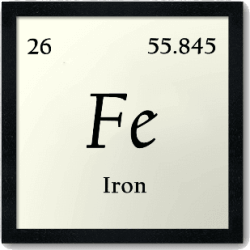Iron & Manganese
Iron and Manganese as a Water Contaminant
In its over 45-years history, the problem most frequently addressed by WETS has been that of iron and manganese contamination in groundwater. Iron and manganese are common elements found in the earth’s crust. Water carries these minerals as it passes through soil and rock. Since well water is typically not exposed to oxygen, the dissolved iron and manganese, on exposure to air, oxidize to form insoluble reddish-brown particles. The presence of only a very small amount of iron and manganese can cause difficulty when the water is used for process or industrial use. Many waters that contain iron also contain manganese; however, iron is more common.
Iron and manganese are classified by the EPA as secondary drinking water contaminants – not a risk to public health, but presenting aesthetic concerns related to taste and appearance, and in staining of laundry and plumbing fixtures.
Other natural water contaminants in the water supply – such as organics, phosphates, complexing ligands, ammonia, and hydrogen sulfide – may bind Fe and Mn or interfere with their oxidation rates. Also, arsenic is often present in combination with iron and/or manganese. Therefore, a WETS pilot study is typically recommended to confirm the proper water treatment for iron removal, especially with the presence of manganese and/or arsenic.
Iron
- Ferrous Bicarbonate Fe(HCO3)2
- Ferrous Carbonate FeCO3
- Ferric Hydroxide Fe(OH)3
- Ferrous Hydroxide Fe(OH)2
- Ferrous Sulfate FeSO4
- Organic Iron
The most common form in which iron is present is ferrous bicarbonate, a soluble colorless salt. Its solubility will increase with an increase in the free carbon dioxide content of the water. In cold water saturated with carbon dioxide, the solubility of ferrous bicarbonate exceeds 150 ppm.
Such waters are usually perfectly clear and colorless when first drawn, but on exposure to the atmosphere, they slowly cloud and finally deposit a yellowish to brownish precipitate of ferric hydroxide. Removal of soluble ferrous bicarbonate from water is achieved by oxidizing and precipitating the iron as ferric hydroxide.
WETS has had great success in the use of aerators for iron removal from water. Aerators have the advantage of reducing the free carbon dioxide content of the water, which simultaneously raises its pH. The resulting precipitates are removed in subsequent sedimentation and filtration steps. Instead of using dissolved oxygen for oxidizing the ferrous iron content of a water, chlorination will additionally help to oxidize ferrous bicarbonate to ferric hydroxide.
While 1 ppm of oxygen will oxidize 7 ppm of ferrous iron, 1 ppm of chlorine will oxidize only about 1.6 ppm of ferrous iron. Because of the high chlorine costs in relying upon chlorination to oxidize ferrous bicarbonate, an aerator is the better method to oxidize ferrous bicarbonate.
Organic iron is organically bound iron combined with decomposed vegetation called tannins or lignins which give it a weak tea or coffee color. Organic iron can be removed by oxidation with chlorine followed by mechanical filtration or by a scavenger anion resin.
Manganese
Many waters that contain iron also contain manganese. However, manganese removal from water often poses more challenges than iron. The soluble manganous salt is slower to oxidize and may require stronger oxidants or pH elevation to form the insoluble manganic salt. Also, chlorine is not as effective in manganese removal from water as it is in iron removal. For manganese, the use of the proper coagulant and flocculent can increase manganese removal in the filtration step. Also, the use of a filtration media coated with manganese oxide (such as Greensand) is effective at removing manganese (and iron).
Therefore, a WETS pilot study will almost always be recommended to identify the proper solution to a manganese problem.
Maximum Contaminant Level
The primary concerns with iron and manganese in groundwater are aesthetic in nature, related to taste and appearance, and also in the staining of plumbing fixtures and laundry. They are therefore classified by the EPA as secondary drinking water contaminants, and not a risk to public health. As secondary contaminants, the EPA-established MCLs are not federal requirements. However, the states can adopt these standards as enforceable standards, and Texas has done so.
EPA established MCL’s:
Iron 0.3 mg/L
Manganese 0.05 mg/L
Public Health Concern
Iron and manganese are not classified as health concerns in drinking water. Instead, they both have secondary or recommended drinking water standards because they cause aesthetic problems that make the water undesirable to use in the home and may cause a bitter metallic taste that can make the water unpleasant to drink for both humans and farm animals.
Iron can also cause an orange or brown stain in sinks and in the laundry. Manganese often results in a dense black stain or solid. For these reasons, as a part of EPA’s Secondary Drinking Water Regulations, it is recommended that drinking water have no more than 0.3 mg/L (or 0.3 parts per million) of iron and less than 0.05 mg/L of manganese.
While manganese is addressed in the secondary standards, which do not address a health risk, there is recent research suggesting that manganese exposure at and above the current standard may be causing developmental issues in smaller children.
WETS Treatment
For iron and manganese removal from water, WETS typically uses aeration followed by filtration, with the possible addition of a coagulant and flocculants.
WETS can perform a pilot study to determine the best method to be used to bring iron and manganese to the desired levels. Often, arsenic will be present in combination with iron and/or manganese. When iron and manganese are in the water, our dual filter media with the proper quantity of coagulant and flocculent will precipitate both iron/manganese and arsenic. Our pilot study will economize on the chemical dosing for the iron and manganese filter and also help on getting TCEQ approval. Our solutions are unique for each plant as we don’t offer an off-the-shelf product.
Solutions to Your Water Treatment Needs
Whether you want a new water treatment system installed, need your current one inspected and repaired, or just want a free quote, contact the WETS LLC. With years of experience in the industry, our skilled team members are trained and knowledgeable with a variety of leading water equipment and products. Our certified water purification experts are here to help.


